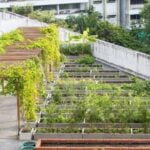Hanging gardens ideas have long been a captivating way to bring lush greenery and natural beauty into any space. From vertical planters to DIY hanging baskets, the possibilities are endless when it comes to creating your own hanging garden oasis. Whether you have a small balcony, a cozy corner in your home, or a sprawling outdoor area, hanging gardens offer a unique way to add color, texture, and life to your surroundings.
Delving into the origins of hanging gardens reveals a rich history steeped in cultural significance. From the legendary Hanging Gardens of Babylon to modern-day adaptations, these elevated green spaces have captured the imaginations of people for centuries. The allure of hanging gardens lies not only in their aesthetic appeal but also in their ability to transform an ordinary space into a vibrant and thriving environment.
By incorporating hanging gardens into your home or outdoor area, you can experience a host of benefits beyond just visual beauty. From purifying the air and reducing stress levels to providing insulation and attracting pollinators, the advantages of embracing hanging gardens are numerous. Whether you’re looking for design inspiration or tips on maintenance, this article will guide you through everything you need to know about creating and caring for your own hanging garden paradise.
History of Hanging Gardens
Hanging gardens have a rich history that dates back centuries, with one of the most famous examples being the legendary Hanging Gardens of Babylon. These gardens were said to have been built by King Nebuchadnezzar II for his wife Amytis, who missed the lush greenery of her homeland.
The Hanging Gardens of Babylon were considered one of the Seven Wonders of the Ancient World and were believed to have been an architectural marvel in Mesopotamia. While some historians debate whether these gardens actually existed or were a legend, they continue to capture our imagination and inspire modern-day hanging garden ideas.
In addition to their mythical origins, hanging gardens have played a significant role in various cultures around the world. In ancient Egypt, for example, royalty often had hanging gardens on their palaces as a sign of wealth and prestige. In medieval Europe, monks cultivated herbs and plants in hanging gardens within monastery walls for medicinal purposes. These historical examples highlight how hanging gardens have not only been utilized for practical reasons but also as symbols of beauty, status, and tranquility.
The concept of hanging gardens has continued to evolve over time, with contemporary designers and homeowners finding innovative ways to incorporate them into urban spaces. From vertical planters suspended from balconies to DIY hanging baskets adorning city streets, hanging gardens offer a versatile solution for adding greenery to limited areas.
Whether you live in a small apartment or own a spacious backyard, there are endless possibilities when it comes to implementing hanging garden ideas that suit your style and space constraints.
Benefits of Hanging Gardens
Hanging gardens have been a popular choice for home and outdoor decor due to their unique design and multiple benefits. One of the main advantages of incorporating hanging gardens into your living space is the ability to maximize limited area.
Whether you have a small balcony or a compact backyard, hanging gardens provide a vertical solution that allows you to enjoy greenery without taking up valuable floor space. This is especially beneficial for urban dwellers or individuals with limited gardening space.
Moreover, hanging gardens can also improve air quality as plants are natural air purifiers. By adding several hanging planters filled with air-purifying plants like spider plants, pothos, or peace lilies, you can create a healthier environment indoors. These plants help filter out toxins and pollutants from the air, promoting better respiratory health and overall well-being for you and your family.
Additionally, incorporating hanging gardens into your home or outdoor area can enhance the aesthetic appeal of the space. The cascading foliage and colorful blooms of hanging plants add texture and visual interest to any setting.
Whether you opt for lush ferns in macrame hangers or vibrant petunias in hanging baskets, the variety of plant options available ensures that you can create a personalized and stylish look that complements your existing decor. In essence, hanging gardens not only bring nature closer but also serve as decorative accents that elevate the overall ambiance of your surroundings.
Design Inspiration
When it comes to creating a hanging garden, the possibilities are endless. Whether you have limited space or simply want to add a touch of greenery to your home, there are numerous design inspirations to choose from. One popular idea is to use vertical planters, which allow you to grow a variety of plants in a small vertical space. Vertical planters can be mounted on walls or fences, providing a stunning display of cascading foliage.
Another creative option for hanging gardens is DIY hanging baskets. You can easily make your own hanging baskets using materials like wire baskets, coconut liners, and sturdy ropes. This allows you to customize the size, shape, and arrangement of your hanging garden to suit your personal style and preferences. DIY hanging baskets are not only cost-effective but also add a unique touch to any outdoor or indoor space.
For those looking for a more modern twist on traditional hanging gardens, consider incorporating geometric shapes and patterns into your design. This could involve using geometric planters, creating symmetry with different types of foliage, or even incorporating metallic accents for a contemporary feel. By thinking outside the box and experimenting with different textures and colors, you can create a one-of-a-kind hanging garden that is sure to impress.
| Key Design Ideas | Description |
|---|---|
| Vertical Planters | Grow various plants in small vertical spaces by mounting planters on walls or fences. |
| DIY Hanging Baskets | Create personalized hanging baskets using wire baskets, coconut liners, and ropes for a unique touch. |
| Geometric Shapes and Patterns | Incorporate modern elements such as geometric planters or metallic accents for a contemporary look. |
Best Plants for Hanging Gardens
When it comes to creating a stunning hanging garden, selecting the right plants is essential. Whether you are looking to add a touch of greenery to your indoor space or enhance your outdoor area with lush foliage, choosing the best plants for hanging gardens can make all the difference. Here are some plant species that thrive in hanging garden environments:
- Spider Plant: Known for its air-purifying qualities, spider plants are low-maintenance and perfect for hanging baskets or vertical planters.
- Pothos: A versatile plant that can thrive in various light conditions, pothos is ideal for cascading down from elevated pots or wall-mounted planters.
- String of Pearls: This unique succulent features trailing stems adorned with bead-like leaves, making it a visually striking addition to any hanging garden.
In addition to these popular options, ferns such as Boston Fern and Maidenhair Fern are excellent choices for hanging gardens due to their graceful fronds and love for humid environments. For those looking to add a pop of color, flowering plants like Begonias and Petunias can bring vibrant hues to your hanging garden display.
Whether you have a sunny balcony or a shaded corner in need of some greenery, there are plenty of plant species that can thrive in hanging garden environments. By carefully selecting the right combination of plants based on their light and water requirements, you can create a lush oasis that transforms any space into a botanical paradise. Explore different textures, colors, and growth habits to design a dynamic hanging garden that suits your personal style and preferences.
Incorporating a variety of plant species into your hanging garden not only adds visual interest but also promotes biodiversity and benefits the ecosystem. From providing oxygen to filtering pollutants from the air, these plants contribute to creating a healthier environment both indoors and outdoors. With the right care and attention, your hanging garden can flourish and bring joy year-round as you enjoy the beauty of nature right at your fingertips.
Hanging Garden Maintenance
When it comes to maintaining a hanging garden, there are some essential tips and tricks that can ensure your green oasis stays healthy and vibrant. One important aspect of hanging garden maintenance is proper watering. Since hanging gardens are exposed to more air, they tend to dry out faster than plants in traditional gardens. It’s crucial to check the moisture levels regularly and water accordingly. Consider installing a drip irrigation system or self-watering planters for consistency in watering.
In addition to watering, pruning is another key aspect of hanging garden care. Regular pruning helps promote new growth, prevents overcrowding, and maintains the overall health of the plants. Trim any dead or yellowing leaves, as well as any overgrown branches or vines. Pruning also helps shape your hanging garden and enhances its aesthetic appeal. Remember to use clean gardening tools to avoid transmitting diseases between plants.
Furthermore, pest control is an essential part of hanging garden maintenance. Inspect your plants regularly for any signs of pests such as aphids, mealybugs, or spider mites. If you notice any infestation, take immediate action using organic pest control methods or insecticidal soap solutions. Keeping pests at bay will help prevent damage to your hanging garden and ensure that your plants continue to thrive.
| Aspect | Tips |
|---|---|
| Watering | Check moisture levels regularly; consider drip irrigation systems |
| Pruning | Regularly trim dead leaves and overgrown branches for plant health |
| Pest Control | Inspect for pests often; use organic pest control methods if needed |
Creative Placement Ideas
On Balconies
One of the most popular and practical locations for hanging gardens is on balconies. Limited space can often be a challenge, but vertical gardening can maximize the area available. Consider using hanging planters or trellises to create a green oasis in your outdoor space.
Additionally, you can add hanging potted plants to railings or walls for a touch of nature without taking up valuable floor space. Mixing different plant varieties with varying heights and textures can create a visually appealing display.
In Offices
Bringing the beauty of nature indoors has become increasingly popular in office environments, with hanging gardens being a creative way to achieve this. Incorporating hanging planters in common areas, such as meeting rooms or break rooms, can help boost productivity and overall mood among employees.
Hanging gardens also work well near large windows to capitalize on natural light and provide a breath of fresh air in enclosed spaces. Choose low-maintenance plants like pothos, spider plants, or succulents that thrive in indoor environments.
In Small Indoor Spaces
For those living in apartments or homes with limited square footage, hanging gardens offer an excellent solution for bringing nature indoors without sacrificing space. Utilize vertical wall planters or DIY hanging baskets to create a mini garden in any room.
Hang small herb pots in the kitchen for easy access while cooking or incorporate cascading plants like string of pearls or English ivy for added visual interest. By using overhead space effectively, even the smallest rooms can benefit from the charm of hanging gardens ideas.
Hanging Garden Decor
As we have explored the allure of hanging gardens, learned about their history, benefits, design inspiration, best plants, maintenance tips, creative placement ideas, it’s time to delve into how to elevate the visual appeal of your hanging garden with the right decor. Incorporating decorative elements such as lights, sculptures, and more can truly transform your space into a captivating oasis.
When it comes to hanging garden decor, lights play a crucial role in creating ambiance and highlighting the beauty of your greenery. Whether you opt for string lights woven through your hanging planters or elegant lanterns placed strategically around your garden, lighting can effortlessly enhance the atmosphere and extend the enjoyment of your outdoor space into the evening hours.
Sculptures and other art pieces can also add personality and charm to your hanging garden. From whimsical statues nestled among the foliage to abstract metal sculptures that catch the light and cast intriguing shadows, incorporating art into your garden design can create focal points and spark conversations among visitors.
Remember to choose pieces that complement the overall aesthetic of your space while adding a unique touch that reflects your personal style. By carefully selecting and arranging decorative elements in your hanging garden, you can create a visually stunning retreat that invites admiration and relaxation.
Frequently Asked Questions
How Do You Start a Hanging Garden?
Starting a hanging garden can be an exciting project that adds greenery to your living space. To begin, choose a location with adequate sunlight and proper drainage.
Then, select the right plants based on the amount of light they need and their size when fully grown. Make sure to use sturdy hooks or brackets to support the weight of the plants and invest in good quality potting mix to ensure healthy growth.
How Do You Make a Simple Vertical Garden?
Creating a simple vertical garden is a great way to maximize space and inject some greenery into your home or outdoor area. Start by choosing a suitable structure for your vertical garden, such as a trellis, pallet, or hanging pockets.
Select plants that thrive in vertical environments, considering factors like sunlight exposure and watering needs. Ensure proper irrigation by installing a drip system or watering regularly as needed.
What Vegetables Grow Best in Vertical Gardens?
When it comes to vegetables that grow best in vertical gardens, certain crops thrive in this unique growing environment. Vegetables like tomatoes, peppers, cucumbers, lettuce, and herbs are well-suited for vertical gardening due to their compact size or climbing habit.
These plants can be grown effectively in containers, hanging baskets, or specialized vertical planters. Just remember to provide adequate support for taller plants and monitor their water and nutrient requirements closely for optimal growth.

Welcome to my gardening blog! I am passionate about plants and enjoy sharing my knowledge and experiences with others. In this blog, I will write about everything related to gardening, from tips on how to get started to updates on my own garden projects.





